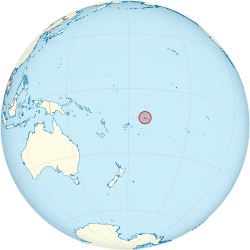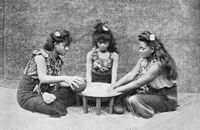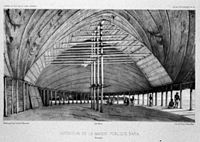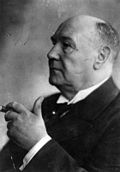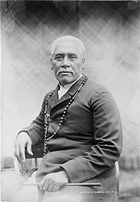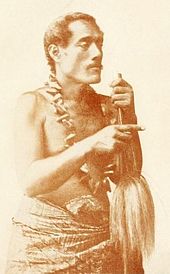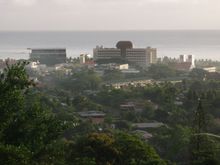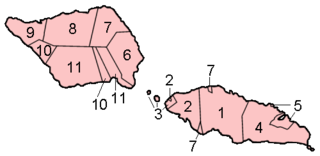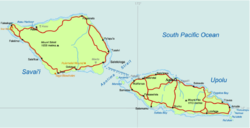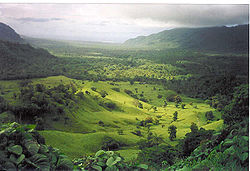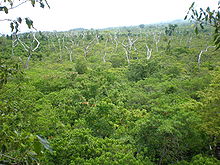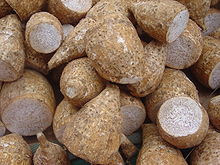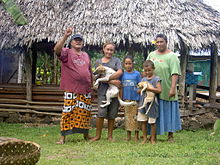
Samoa
Did you know...
The articles in this Schools selection have been arranged by curriculum topic thanks to SOS Children volunteers. With SOS Children you can choose to sponsor children in over a hundred countries
| Independent State of Samoa Malo Saʻoloto Tutoʻatasi o Sāmoa
|
||||||
|---|---|---|---|---|---|---|
|
||||||
| Motto: "Fa'avae i le Atua Sāmoa" "Samoa is founded on God" |
||||||
| Anthem: The Banner of Freedom | ||||||
|
|
||||||
| Capital and largest city |
Apia 13°50′S 171°45′W |
|||||
| Official languages |
|
|||||
| Ethnic groups (2001) |
|
|||||
| Demonym | Samoan | |||||
| Government | Unitary parliamentary republic | |||||
| - | O le Ao o le Malo a | Tufuga Efi | ||||
| - | Prime Minister | Tuilaepa Aiono Sailele Malielegaoi | ||||
| Legislature | Legislative Assembly | |||||
| Independence | ||||||
| - | from New Zealand | 1 January 1962 | ||||
| Area | ||||||
| - | Total | 2,831 km2 ( 174th) 1,093 sq mi |
||||
| - | Water (%) | 0.3 | ||||
| Population | ||||||
| - | 2012 estimate | 194,320 ( 166th) | ||||
| - | 2006 census | 179,186 | ||||
| - | Density | 63.2/km2 ( 144th) 163.7/sq mi |
||||
| GDP ( PPP) | 2011 estimate | |||||
| - | Total | $1.090 billion | ||||
| - | Per capita | $5,965 | ||||
| GDP (nominal) | 2011 estimate | |||||
| - | Total | $630 million | ||||
| - | Per capita | $3,451 | ||||
| HDI (2013) | medium · 96th |
|||||
| Currency | Tala ( WST) |
|||||
| Time zone | UTC+13:00 ( UTC+13b) | |||||
| - | Summer ( DST) | UTC+14:00 ( UTC+14) | ||||
| Drives on the | leftc | |||||
| Calling code | +685 | |||||
| ISO 3166 code | WS | |||||
| Internet TLD | .ws | |||||
| a. | Head of state. | |||||
| b. | Since 31 December 2011. | |||||
| c. | Since 7 September 2009. | |||||
Samoa ( / s ə ˈ m oʊ . ə /; Samoan: Sāmoa, IPA: [ˌsaːˈmoa]), officially the Independent State of Samoa ( Samoan: Malo Sa'oloto Tuto'atasi o Sāmoa), formerly known as Western Samoa, is a country encompassing the western part of the Samoan Islands in the South Pacific Ocean. It became independent from New Zealand in 1962. The two main islands of Samoa are Upolu and one of the biggest islands in Polynesia, Savai'i. The capital city, Apia, and Faleolo International Airport are situated on the island of Upolu.
Samoa was admitted to the United Nations on 15 December 1976. The entire island group, inclusive of American Samoa, was called "Navigators Islands" by European explorers before the 20th century because of the Samoans' seafaring skills.
History
The oldest date so far from pre-historic remains in Samoa has been calculated by New Zealand scientists to a likely true age of circa 3,000 years ago from a Lapita site at Mulifanua during the 1970s.
The origins of the Samoans is closely linked to modern research about Polynesia in various scientific disciplines such as genetics, linguistics and anthropology. Scientific research is ongoing although a number of different theories exist; including one proposing that the Samoans originated from Austronesian predecessors during the terminal eastward Lapita expansion period from Southeast Asia and Melanesia between 2,500 and 1,500 BCE. The Samoan origins are currently being reassessed due to new scientific evidence and carbon dating findings from 2003 and onwards.
Intimate sociocultural and genetic ties were maintained between the eastern Lapita colonies and the archaeological record supports oral tradition and native genealogies that indicate inter-island voyaging and intermarriage between prehistoric Samoans, Fijians, and Tongans.
Contact with Europeans began in the early 18th century. Jacob Roggeveen (1659–1729), a Dutchman, was the first known European to sight the Samoan islands in 1722. This visit was followed by French explorer Louis-Antoine de Bougainville (1729–1811), who named them the Navigator Islands in 1768. Contact was limited before the 1830s which is when English missionaries and traders began arriving.
Mission work in Samoa had begun in late 1830 by John Williams, of the London Missionary Society arriving in Sapapali'i from The Cook Islands and Tahiti. According to Barbara A. West, "The Samoans were also known to engage in 'headhunting,' a ritual of war in which a warrior took the head of his slain opponent to give to his leader, thus proving his bravery." There is recorded history of an event which took place when two German lives were taken and then their corpses beheaded by a citizen during that nation's administration of Samoa. A return attempt between two Samoans lead to similar beheading although the practice was know not to be condoned amongst Samoans. The event precedes the short time before further tripartite conflict for the territories. Robert Louis Stevenson, the author who lived in Samoa from 1889 wrote in his recordings of the period 1882–1892 A Footnote to History: Eight Years of Trouble in Samoa, "The Samoans are gentle people."
The Germans in particular began to show great commercial interest in the Samoan Islands, especially on the island of 'Upolu where German firms monopolised copra and cocoa bean processing; the United States laid its own claim and formed alliances with local native chieftains, most conspicuously on the islands of Tutuila and Manu'a (which were later formally annexed to the USA as American Samoa).
Britain also sent troops to protect British business enterprise, harbour rights, and consulate office. There followed an eight-year civil war, where each of the three powers supplied arms, training, and in some cases, combat troops to the warring Samoan parties. The Samoan crisis came to a critical juncture in March 1889 when all three colonial contenders sent warships into Apia harbour, and a larger-scale war seemed imminent, until a massive storm on 15 March 1889 damaged or destroyed the warships, ending the military conflict.
The Second Samoan Civil War was a conflict that reached a head in 1898 when Germany, the United Kingdom, and the United States were locked in dispute over who should have control over the Samoa Islands. The Siege of Apia occurred during the Second Samoan Civil War in March 1899 at Apia. Samoan forces loyal to Prince Tanu were besieged by a larger force of Samoan rebels loyal to Mata'afa Iosefo. Supporting Prince Tanu were landing parties from four British and American warships. Over the course of several days of fighting, the Samoan rebels were defeated. American and British warships shelled Apia on 15 March 1899; including the USS Philadelphia. Germany, the United Kingdom and the United States quickly resolved to end the hostilities; with the partitioning of the island chain at the Tripartite Convention of 1899.
20th century
The Tripartite Convention of 1899 partitioned the Samoan Islands into two parts: the eastern island group became a territory of the United States (the Tutuila Islands in 1900 and officially Manu'a in 1904) and is today known as American Samoa; the western islands, by far the greater landmass, became known as German Samoa after Britain vacated all claims to Samoa and accepted termination of German rights in Tonga and certain areas in the Solomon Islands and West Africa.
By 1912 the German administration had apparently achieved its long-term objective of understanding the traditional forces in Samoa politics while maintaining a semblance of local participation in government. There was no more Tupu (King), nor even alii sili (similar to a governor), but the two Fautua (Advisors) were appointed. Tumua and Pule (traditional governments of Upolu and Savaii) were for a time silent; all decisions on matters affecting lands and titles were under the control of the Governor. To complete the process, the Fa’alupega for all Samoa was revised. In a culture based on oratory, the Fa’alupega is a formal greeting which acknowledges those being greeted and their status. The Fa’alupega, which had been nationally accepted from at least the late 19th century (and probably for much longer than that), was as follows:
"Tulouna a Tumua ma Pule,
Tulouna a Itu’au ma Alataua,
Tulouna a Aiga-i-le-Tai,
Ma le Va’a-o-Fonoti,
Tulouna a Tama ma a latou aiga
Po’o aiga ma a latou tama".
This firstly recognised the authority and identity of principal districts of Samoa through their spokesmen – Tumua ma Pule, Itu’au ma Alataua, Aiga-i-le-Tai, and the Va'a-o-Fonoti – and the highest titles which were bestowed by these groups. It concludes with the recognition of the great maximal descent groups of Samoa and their "sons" who had been chosen to hold the highest titles.
The new Fa’alupega of German Samoa, which in its first line recognises the Kaiser (Kaisa), apparently required Malietoa Tanumafili and Tupua Tamasese to be sworn on oath to become advisors to the governing council:
"Tulouna a lana Maiesitete le Kaisa o le tupu mamalu o lo tatou malo kasialika aoao.
Tulouna a lana afioga le kovana kasialika o le sui o le kaisa I Samoa nei.
Susu mai Malietoa, Afio mai Tupua
Ua fa’amanatuiana ai aiga e lua I o oulua tofiga Kasialika o le Fautua.
Tulouna a le vasega a Faipule Kasialika o e lagolago malosi I le Malo.
Afifio mai le nofo a vasega o tofiga Kasialika o e usu fita I le tautua I le malo".
The first German Governor, Wilhelm Solf, later went on to become Secretary for the Colonies of Imperial Germany. New Zealand troops landed on 'Upolu unopposed on 29 August 1914 and seized control from the German authorities, following a request by Britain for New Zealand to perform their "great and urgent imperial service."
From the end of World War I until 1962, New Zealand controlled Samoa as a Class C Mandate under trusteeship through the League of Nations, then through the United Nations. There followed a series of New Zealand administrators who were responsible for two major incidents. In the first incident, approximately one fifth of the Samoan population died in the influenza epidemic of 1918–1919. In 1919 The Royal Commission of Inquiry into the Epidemic concluded that there had been no epidemic of pneumonic influenza in Western Samoa before the arrival of the SS Talune from Auckland on 7 November 1918. The NZ administration allowed the ship to berth in breach of quarantine; within seven days of this ship's arrival influenza became epidemic in Upolu and then spread rapidly throughout the rest of the territory.
The second major incident arose out of an initially peaceful protest by the Mau (which literally translates as "strongly held opinion"), a non-violent popular movement which had its beginnings in the early 1900s on Savai'i, led by Lauaki Namulauulu Mamoe, an orator chief deposed by Solf. In 1909, Lauaki was exiled to Saipan and died en route back to Samoa in 1915.
By 1918, Samoa had population of some 38,000 Samoans and 1,500 Europeans. By the late 1920s the resistance movement against colonial rule had gathered widespread support during the mistreatment of the Samoan people by the New Zealand administration. One of the Mau leaders was Olaf Frederick Nelson, a half Samoan and half Swedish merchant. Nelson was eventually exiled during the late 1920s and early 1930s, but he continued to assist the organisation financially and politically. In accordance with the Mau's non-violent philosophy, the newly elected leader, High Chief Tupua Tamasese Lealofi, led his fellow uniformed Mau in a peaceful demonstration in downtown Apia on 28 December 1929.
The New Zealand police attempted to arrest one of the leaders in the demonstration. When he resisted, a struggle developed between the police and the Mau. The officers began to fire randomly into the crowd and a Lewis machine gun, mounted in preparation for this demonstration, was used to disperse the demonstrators. Chief Tamasese was shot from behind and killed while trying to bring calm and order to the Mau demonstrators, screaming "Peace, Samoa". Ten others died that day and approximately 50 were injured by gunshot wounds and police batons.
That day would come to be known in Samoa as Black Saturday. The Mau grew, remaining steadfastly non-violent, and expanded to include a highly influential women's branch. After repeated efforts by the Samoan people, Western Samoa gained independence in 1962 and signed a Friendship Treaty with New Zealand. Samoa, the first small-island country in the Pacific to become independent, joined the Commonwealth of Nations on 28 August 1970. In 2002, New Zealand's prime minister Helen Clark, on a trip to Samoa, formally apologised for New Zealand's role in the events of 1918 and 1929.
In July 1997 the government amended the constitution to change the country's name from Western Samoa to Samoa. The US territory of American Samoa protested the move, asserting that the change diminished its own identity. As of 2012 American Samoans still use the terms Western Samoa and Western Samoans to describe the independent State of Samoa and its inhabitants. Travel writer Paul Theroux noted marked differences between the societies in Samoa and American Samoa.
21st century
From 7 September 2009, the government has changed the driving orientation for motorists and Samoans now drive on the left hand side of the road. This brings Samoa into line with many other countries in the region. Samoa is the first country in recent years, and the first in the 21st century, to switch to driving on the left.
At the end of December 2011, Samoa jumped forward by one day, omitting 30 December from the local calendar, when the nation moved to the west of the International Date Line. This was designed to help the nation boost its economy by doing business with Australia and New Zealand. Before this change, Samoa was 21 hours behind Sydney, but the change means it is now three hours ahead. The previous timezone was agreed on 4 July 1892, to work in line with American traders based in California.
Politics
The 1960 constitution, which formally came into force with independence from New Zealand in 1962, is based on the British pattern of parliamentary democracy, modified to take account of Samoan customs. The national modern Government of Samoa is referred to as the 'Malo'. Samoa's first Prime Minister was Fiame Mata'afa Faumuina Mulinu’u II, one of the four highest-ranking paramount chiefs in the country. Two other paramount chiefs at the time of independence were appointed joint heads of state for life. Tupua Tamasese Mea'ole died in 1963, leaving Malietoa Tanumafili II sole head of state until his death on 11 May 2007, upon which Samoa changed from a constitutional monarchy to a parliamentary republic. The next Head of State, Tuiatua Tupua Tamasese Efi, was elected by the legislature on 17 June 2007 for a fixed five-year term.
The unicameral legislature ( Fono) consists of 49 members serving 5-year terms. Forty-seven are matai title holders elected from territorial districts by Samoans; the other two are chosen by non-Samoans with no chiefly affiliation on separate electoral rolls. Universal suffrage was extended in 1990, but only chiefs (matai) may stand for election to the Samoan seats. There are more than 25,000 matais in the country, about 5% of whom are women. The prime minister is chosen by a majority in the Fono and is appointed by the head of state to form a government. The prime minister's choices for the 12 cabinet positions are appointed by the head of state, subject to the continuing confidence of the Fono.
Prominent women in Samoan politics include the late Laulu Fetauimalemau Mata'afa (1928–2007) from Lotofaga constituency, the wife of Samoa's first prime minister. Their daughter Fiame Naomi Mata'afa is a paramount chief and a long-serving senior member of cabinet. Other women in politics include Samoan scholar and eminent professor Aiono Fanaafi Le Tagaloa, orator-chief Matatumua Maimoana and Safuneitu'uga Pa'aga Neri, the current Minister of Communication and Technology.
The judicial system is based on English common law and local customs. The Supreme Court of Samoa is the court of highest jurisdiction. Its chief justice is appointed by the head of state upon the recommendation of the prime minister.
Districts
Samoa is made up of eleven itūmālō (political districts). These are the traditional eleven districts that were established well before European arrival. Each district has its own constitutional foundation (faavae) based on the traditional order of title precedence found in each district's faalupega (traditional salutations).
The capital village of each district administers and coordinates the affairs of the district and confers each districts' paramount title, amongst other responsibilities. For example, the District of A'ana has its capital at Leulumoega. The paramount title of A'ana is the TuiA'ana. The orator group which confers this title – the Faleiva (House of Nine) – is based at Leulumoega. This is also the same for the other districts. In the district of Tuamasaga, the paramount title of the district – The Malietoa title – is conferred by the FaleTuamasaga based in Afega.
|
|
1 including islands Manono, Apolima and Nu'ulopa
2 including the Aleipata Islands and Nu'usafe'e Island
3 smaller parts also on Upolu (Salamumu (incl. Salamumu-Utu) and Leauvaa villages)
Geography
Samoa is located south of the equator, about halfway between Hawai‘i and New Zealand in the Polynesian region of the Pacific Ocean. The total land area is 2,934 km² (1,133 sq mi), consisting of the two large islands of Upolu and Savai'i which account for 99% of the total land area, and eight small islets.
These are the three islets in the Apolima Strait ( Manono Island, Apolima and Nu'ulopa), the four Aleipata Islands off the eastern end of Upolu ( Nu'utele, Nu'ulua, Namua, and Fanuatapu), and Nu'usafe'e (less than 0.01 km² – 2½ acres – in area and about 1.4 km (0.9 mi) off the south coast of Upolu at the village of Vaovai). The main island of Upolu is home to nearly three-quarters of Samoa's population, and its capital city is Apia.
The Samoan islands have been produced by vulcanism, the source of which is the Samoa hotspot which is probably the result of a mantle plume. While all of the islands have volcanic origins, only Savai'i, the western most island in Samoa, is volcanically active with the most recent eruptions in Mt Matavanu (1905–1911), Mata o le Afi (1902) and Mauga Afi (1725). The highest point in Samoa is Mt Silisili, at 1858 m (6,096 ft). The Saleaula lava fields situated on the central north coast of Savai'i are the result of the Mt Matavanu eruptions which left 50 km² (20 sq mi) of solidified lava.
Samoa was previously located east of the international date line but in 2011, Samoan Prime Minister Tuilaepa Sailele announced his country would move the International Date Line to the east of the country, so that Samoa would lie to the west of the date line. This change took effect on the night of 29 December, so that the Friday was skipped altogether and the following day was Saturday 31 December.
Climate
The climate is equatorial/monsoonal, with an average annual temperature of 26.5 °C (79.7 °F), and a rainy season from November to April. Savai'i is the largest of the Samoan islands and the sixth largest Polynesian island after New Zealand's North, South and Stewart Islands and the Hawaiian islands of Hawaiʻi and Maui. The population of Savai'i is 42,000 people.
| Climate data for Apia | |||||||||||||
|---|---|---|---|---|---|---|---|---|---|---|---|---|---|
| Month | Jan | Feb | Mar | Apr | May | Jun | Jul | Aug | Sep | Oct | Nov | Dec | Year |
| Average high °C (°F) | 30.4 (86.7) |
30.6 (87.1) |
30.6 (87.1) |
30.7 (87.3) |
30.4 (86.7) |
30.0 (86) |
29.5 (85.1) |
29.6 (85.3) |
29.9 (85.8) |
30.1 (86.2) |
30.3 (86.5) |
30.5 (86.9) |
30.22 (86.39) |
| Average low °C (°F) | 23.9 (75) |
24.2 (75.6) |
24.0 (75.2) |
23.8 (74.8) |
23.4 (74.1) |
23.2 (73.8) |
22.6 (72.7) |
22.8 (73) |
23.1 (73.6) |
23.4 (74.1) |
23.6 (74.5) |
23.8 (74.8) |
23.48 (74.27) |
| Precipitation mm (inches) | 489.0 (19.252) |
368.0 (14.488) |
352.1 (13.862) |
211.2 (8.315) |
192.6 (7.583) |
120.8 (4.756) |
120.7 (4.752) |
113.2 (4.457) |
153.9 (6.059) |
224.3 (8.831) |
261.7 (10.303) |
357.5 (14.075) |
2,965 (116.733) |
| Source: World Meteorological Organization (UN) | |||||||||||||
Environment
Samoa is located within the Samoan tropical moist forests ecoregion. Since human habitation began, about 80% of the lowland rain forests has been lost. Within the ecoregion about 28% of plants and 84% of land birds are endemic.
Economy
Gross Domestic Product (GDP) in purchasing power parity (PPP) in 2006 was estimated at $1.218 billion USD. The industrial sector is the largest component of GDP at 58.4%, followed by the services sector at 30.2% (2004 est.). Agriculture represents only 11.4% of GDP (2004 est.). Samoan labour force is estimated at 90,000.
The country currency is the Samoan tālā, issued and regulated by the Central Bank of Samoa. The economy of Samoa has traditionally been dependent on agriculture and fishing at the local level. In modern times, development aid, private family remittances from overseas, and agricultural exports have become key factors in the nation's economy. Agriculture employs two-thirds of the labour force, and furnishes 90% of exports, featuring coconut cream, coconut oil, noni (juice of the nonu fruit, as it is known in Samoan), and copra.
Outside of a large automotive wire harness factory ( Yazaki Corporation), the manufacturing sector mainly processes agricultural products. Tourism is an expanding sector which now accounts for 25% of GDP. Tourist arrivals have been increasing over the years with more than 100,000 tourists visiting the islands in 2005, up from 70,000 in 1996.
The Samoan government has called for deregulation of the financial sector, encouragement of investment, and continued fiscal discipline. Observers point to the flexibility of the labour market as a basic strength for future economic advances. The sector has been helped enormously by major capital investment in hotel infrastructure, political instability in neighbouring Pacific countries, and the 2005 launch of Virgin Samoa a joint-venture between the government and Virgin Australia (then Virgin Blue).
In the period before German colonisation, Samoa produced mostly copra. German merchants and settlers were active in introducing large scale plantation operations and developing new industries, notably cocoa bean and rubber, relying on imported labourers from China and Melanesia. When the value of natural rubber fell drastically, about the end of the Great War (World War I), the New Zealand government encouraged the production of bananas, for which there is a large market in New Zealand.
Because of variations in altitude, a large range of tropical and subtropical crops can be cultivated, but land is not generally available to outside interests. Of the total land area of 2,934 km² (725,000 acres), about 24.4% is in permanent crops and another 21.2% is arable. About 4.4% is Western Samoan Trust Estates Corporation (WSTEC).
The staple products of Samoa are copra (dried coconut meat), cocoa bean (for chocolate), and bananas. The annual production of both bananas and copra has been in the range of 13,000 to 15,000 metric tons (about 14,500 to 16,500 short tons). If the rhinoceros beetle in Samoa were eradicated, Samoa could produce in excess of 40,000 metric tons (44,000 short tons) of copra. Samoan cocoa beans are of very high quality and used in fine New Zealand chocolates. Most are Criollo-Forastero hybrids. Coffee grows well, but production has been uneven. WSTEC is the biggest coffee producer. Rubber has been produced in Samoa for many years, but its export value has little impact on the economy.
Other agricultural industries have been less successful. Sugarcane production, originally established by Germans in the early 20th century, could be successful. Old train tracks for transporting cane can be seen at some plantations east of Apia. Pineapples grow well in Samoa, but beyond local consumption have not been a major export.
Demographics
Samoa has a population of 182,265 of which 92.6% are Samoans, 7% Euronesians (people of mixed, European and Polynesian ancestors) and 0.4% are Europeans, per the CIA World Factbook. About three-quarters of the population live on the main island of Upolu. Only the Māori of New Zealand outnumber Samoans among Polynesian groups.
Samoans' religious adherence includes the following: Christian Congregational Church of Samoa 35.5%, Roman Catholic 19.6%, Methodist 15%, Latter-day Saints 12.7%, Samoan Assemblies of God 10.6%, Seventh-day Adventist 3.5%, Worship Centre 1.3%, unspecified 0.8% (2001 census). The Head of State until 2007, His Highness Malietoa Tanumafili II, was a Bahá'í convert. Samoa hosts one of seven Bahá'í Houses of Worship in the world; completed in 1984 and dedicated by the Head of State, it is located in Tiapapata, 8 km (5 mi) from Apia.


